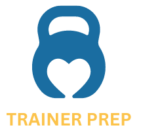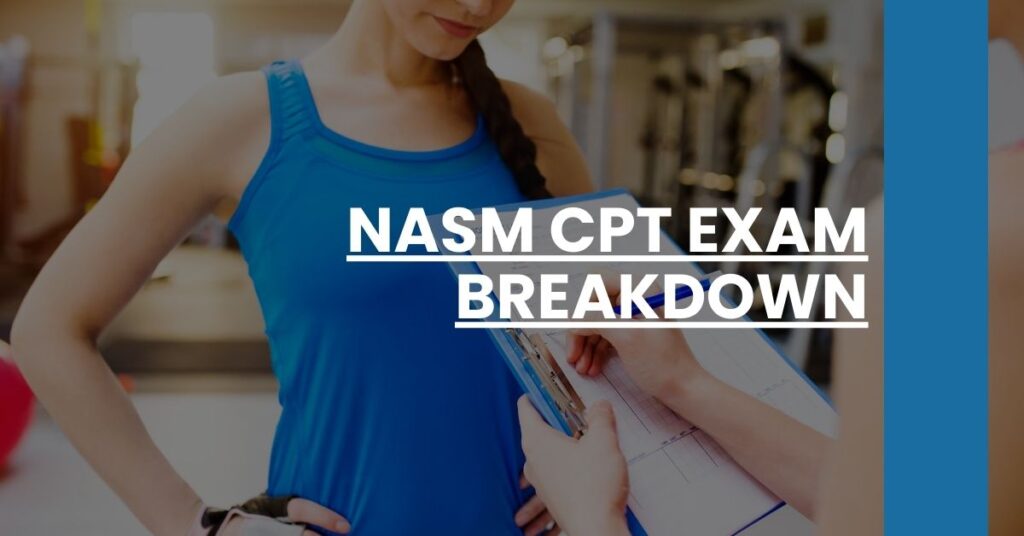The NASM CPT Exam is a certification test for personal trainers, featuring 120 multiple-choice questions over a 2-hour duration. Key domains include Exercise Technique, Program Design, and Nutrition, each with designated weightings. To pass, you’ll need a scaled score of 70. Our guide details resources, tips, and a breakdown of the OPT Model to help you succeed.
Overview of the NASM CPT Exam Structure
Understanding the structure of the NASM CPT Exam is the first step in your preparation journey. The exam’s layout provides insight into the topics you’ll need to master and how to effectively allocate your study time.
Number of Questions and Types
The NASM CPT Exam consists of 120 multiple-choice questions. These questions are designed to assess your understanding across various domains required for personal training. Multiple-choice questions test not just your recall of information but your ability to apply knowledge in practical scenarios.
Duration
You will have 2 hours to complete the exam. Time management during the exam is crucial. Practicing with timed mock exams can help you pace yourself, ensuring you can answer all questions within the allotted time.
Scoring and Passing Threshold
The NASM CPT Exam uses a scaled scoring system, with the passing score set at 70. This scaled score accounts for variations in difficulty across different exam versions, ensuring fairness for all test-takers.
Key Focus Areas
The exam covers six primary domains. Here’s a breakdown of each domain’s weight:
- Basic and Applied Sciences and Nutritional Concepts (17%)
- Assessment (18%)
- Program Design (21%)
- Exercise Technique and Training Instruction (22%)
- Client Relations and Behavioral Coaching (12%)
- Professional Development and Responsibility (10%)
Knowing these percentages helps you focus your studies on the areas that carry the most weight. For instance, Program Design and Exercise Technique combined cover 43% of the exam, requiring more intensive preparation.
Key Domains Covered in the NASM CPT Exam
Basic and Applied Sciences and Nutritional Concepts (17%)
This section covers foundational knowledge, including human anatomy, exercise physiology, and nutritional science. Expect questions that test your understanding of how the body functions during physical activity and how nutrition impacts performance and recovery.
Assessment (18%)
In this domain, you’ll be tested on your ability to conduct fitness assessments. This involves understanding and applying various types of assessments (e.g., postural, movement, cardiovascular) to create effective fitness plans. Accurate assessment is vital for identifying client needs and baseline fitness levels.
Program Design (21%)
Program design is the heart of personal training. You’ll need to demonstrate your ability to create custom training programs tailored to individual clients. This includes setting exercise routines that align with the client’s goals and limitations while adhering to safety guidelines.
Exercise Technique and Training Instruction (22%)
A significant portion of the exam focuses on exercise techniques and training instruction. Here, you’ll need to showcase your knowledge of proper exercise form, equipment usage, and instructional strategies to ensure clients perform exercises safely and effectively.
Client Relations and Behavioral Coaching (12%)
This domain emphasizes the interpersonal aspect of personal training. Questions will gauge your competence in building client relationships, understanding behavioral change theories, and employing coaching strategies to motivate clients and foster adherence.
Professional Development and Responsibility (10%)
Lastly, this section addresses professional ethics, business acumen, and ongoing professional development. As a personal trainer, maintaining high ethical standards and committing to continuous learning are crucial.
Study Materials and Resources for the NASM CPT Exam
Books and Official Study Guides
To adequately prepare for the NASM CPT Exam, you’ll need robust study materials. The official NASM textbook and study guide are your primary resources. These materials cover all key domains and provide comprehensive explanations of essential concepts.
Practice Exams
Practice exams are indispensable. They simulate the test environment, making you comfortable with the format and time constraints. The NASM provides several practice exams. These are vital for identifying your strengths and areas that need improvement.
Online Courses and Flashcards
Several reputable online courses—like those offered by TrainerPrep—can supplement your study. These courses often include video tutorials, interactive quizzes, and additional study aids. Flashcards, such as those available from Brainscape, allow for quick and effective memorization of important terms and concepts.
Study Tips
- Create a Structured Study Schedule: Allocate specific times for different domains. Prioritize high-weight domains like Program Design and Exercise Technique.
- Engage in Active Learning: Take notes, create diagrams, and discuss concepts with study partners to reinforce your understanding.
- Utilize a Variety of Ressources: Combine textbooks, online courses, flashcards, and practice exams. This multimodal approach caters to different learning styles.
- Regular Practice Tests: Take full-length practice tests under timed conditions. Review your answers thoroughly to understand mistakes and correct them.
In addition, TrainerPrep offers specially designed courses and practice exams that align with NASM’s curriculum, ensuring you have the right tools to excel. Explore our Training Resources to access these valuable aids.
Arming yourself with these comprehensive resources and employing effective study strategies will set you on the path to success in your NASM CPT Exam.
Tips and Strategies for Passing the NASM CPT Exam
Proper preparation requires a set of strategies tailored to the structure and demands of the NASM CPT Exam. Here are some tips to help you succeed.
Time Management Techniques
Allocating your study time efficiently can make a significant difference in understanding and retaining material.
- Prioritize High-Weight Domains: Focus your time on areas that account for a larger percentage of the exam, such as Program Design and Exercise Technique.
- Set a Study Schedule: Break down your study sessions into manageable chunks. Consistent, shorter sessions are more effective than cramming.
- Include Regular Breaks: Rest periods can enhance your recall and retention capabilities.
Utilizing Practice Tests
Practice exams replicate the actual test environment, helping you build familiarity and confidence.
- Simulate Real Exam Conditions: Take these tests under timed conditions to improve your pacing.
- Analyze Your Results: Review both correct and incorrect answers to understand your thought process and identify areas of confusion.
Focus on Key Topics
Certain topics appear prominently on the exam. Concentrating on them can provide a high return on your study time investment.
- OPT Model: Understand all five phases thoroughly, including the purpose and application of each phase.
- Muscle Imbalances and Corrective Exercise: Be aware of how to identify and address common muscle imbalances.
- Nutrition Basics: Know how nutritional principles apply to fitness and client goals.
Join Study Groups
Collaborative learning can provide diverse insights and keeps you motivated.
- Discuss Difficult Topics: Clarifying doubts with peers can enhance understanding.
- Share Study Resources: Pooling notes and access to various materials enriches your preparation toolkit.
Active Learning Techniques
Engage with the material through various sensory modalities.
- Create Visual Aids: Use diagrams to visualize anatomical structures and movements.
- Teach Back Method: Try teaching a concept to someone else. Explaining a topic can solidify your grasp on it.
Stay Physically Active
Being active isn’t just part of the subject matter—it also helps boost cognitive function and reduce stress.
- Incorporate Regular Workouts: Maintain your own fitness regimen as you study. It enhances brain function and overall well-being.
- Practice Exercises You Teach: Familiarity with exercises via physical practice ensures you understand them deeply.
Understanding the NASM OPT Model
The NASM Optimum Performance Training (OPT) Model is integral to the CPT curriculum. It lays the foundation for creating effective, science-based exercise programs.
The Five Phases of the OPT Model
- Stabilization Endurance: This phase focuses on improving muscular endurance and stability. Techniques include proprioceptively enriched exercises and low loads with high repetitions.
- Strength Endurance: It ensures strength endurance for overall fitness improvement. It includes superset techniques, combining strength and stabilization exercises.
- Hypertrophy: Aimed at increasing muscle size, this phase employs moderate to high loads with moderate to high repetitions (6-12).
- Maximal Strength: Maximizing the amount one can lift. This phase uses high loads with low repetitions (1-5), focusing on the peak force.
- Power: Enhances speed and power. This involves high-speed contractions, typically using light loads explosively.
Importance of the OPT Model in Personalized Training Programs
The structured progression allows trainers to tailor programs specific to individual needs and fitness levels.
- Adaptation: Clients progressively adapt, reducing the risk of overtraining and injury.
- Variety: A multi-phase approach helps keep workouts engaging and challenging.
- Goal-Oriented: Each phase aligns with different fitness goals, from weight loss to performance enhancement.
Key Elements in Program Design
Reliably follow program variables including intensity, volume, and rest intervals to ensure each phase’s effectiveness in achieving specific goals.
Common Questions About the NASM CPT Exam
What is the Pass Rate?
The pass rate for the NASM CPT Exam is approximately 65-70%. This suggests a significant number of candidates successfully certify, but it also underscores the need for thorough preparation.
How Much Does the Exam Cost?
The cost of the exam is around $599. Various payment plans are available, which can make budgeting for your certification more manageable.
What if I Fail? Retake Policies
Failing the exam isn’t the end of the road.
- First Retake: You can retake the exam after a one-week waiting period.
- Subsequent Retakes: A 30-day waiting period applies before trying a third time, with a yearly wait if further attempts are needed.
How Often Do I Need to Renew My Certification?
Certification renewal is required every two years. This ensures personal trainers stay current with industry developments.
- Continuing Education Units (CEUs): You must complete 1.9 CEUs (19 contact hours).
- Renewal Fee: A small fee is applicable, currently set at approximately $99.
For more information and resources, explore the NASM Certification Renewal Guidelines.
Conclusion: Mastering the NASM CPT Exam
Mastering the NASM CPT Exam sets a strong foundation for a successful career in personal training. Utilize the provided resources, adopt effective study strategies, and focus on understanding key concepts like the OPT Model. With dedication and the right preparation, you’ll be well on your way to achieving certification and excelling in the fitness industry.

